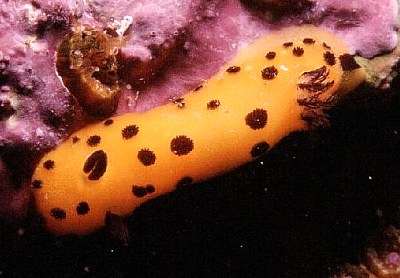Re: Is this a Jorunna sp??
November 1, 1999
From: Erik Schloegl

Dear Bill,
This is a nudibranch I've been wondering about for a long time, too. It's certainly one of the more common species along the New South Wales coast. The attached photo was taken at Long Reef (just off Sydney's Northern Beaches), on June 14, 1999, at a depth of about 15m. Whenever I see this species I wonder why it hasn't been described yet and what it takes to describe a (nudibranch) species. Could you comment on this?
Thanks,
Erik Schloegl
schloegl@maths.uts.edu.au
Schloegl, E., 1999 (Nov 1) Re: Is this a Jorunna sp??. [Message in] Sea Slug Forum. Australian Museum, Sydney. Available from http://www.seaslugforum.net/find/1456Dear Erik,
Yes it is what I am calling Jorunna sp. 2 - which is the easiest part of your question to answer.
What does it take to describe a species? is not so easy. Once you have decided a 'species' is distinct from all others and does not already have a name, you can name it by publishing an 'adequate' description in a reputable scientific journal. You need to follow the International Code of Zoologcial Nomenclature, which has just been revised, but apart from that you are effectively on you own. Now if you say all that very quickly it seems quite simple, however, as with most things, it is not quite as simple as it at first may appear.
Firstly, the underlying rule of the International Code, is the Law of Priority. Basically the first valid name given to a species has priority over all subsequent names.
Secondly, most practising taxonomists consider the binomial naming system we use is more than just a process to give unique names to all organisms. Modern nomenclature attempts to reflect, to the best of our ability, the evolutionary, or phylogenetic realtionships between the organisms. If you look at the Species List the various categories such as ORDER, SUPERFAMILY, FAMILY etc should not be thought of so much as a hierarchy, but as a grouping, at each level, of organisms with a common ancestry. The naming system should be a simple way to show evolutionary relationships. All species in Genus 1 are more closely related to each other than they are to species in Genus 2. All species in Family 1 are more closely related to each other than they are two species in Family 2 etc.
Discovering whether your 'new' species already has a name, is a major problem. In earlier times, species were often named in a very cursory manner, often a 3 line (not three sentence) description, with no illustration was considered sufficient. In many parts of the world there are still considerable debates about the identity of some early names, and until many of these early names are better understood, there will continue to be problems.
Understanding relationships between species is also a time-consuming task, requiring the comparative studies on the anatomy of the relevant species. In the past, many workers who thought they had a new species just published it as "A new species from X" or "A new species of the genus X", with little consideration for biogeography, phylogenetic relationships etc. Or else we had papers on "A collection of species from my summer holidays" where again no consideration was given to the phylogeny of the species involved, which could include a sacoglossan, an aeolid, a dorid etc. Today, most professional workers consider it necessary to describe new species in the context of a review of related species. Only in cases where the relevant genus has recently been adequately reviewed, is there much point in publishing single species descriptions.
Some years ago I reviewed the genus Rostanga (see Rudman & Avern,1989) which is quite similar to Jorunna in external features, other than colour. At that time I began accumulating and dissecting specimens of Jorunna-like animals for a similar publication. It is still in preparation, not through lack of effort, but through the need to collect more specimens of some of the problematic species. To name this black-spotted species is less important to me than understanding the relationships of the group. Naming new species should not be a 'race'. It should be the result of some substantial and professional effort.
Unfortunately, taxonomy is the one science where you can't ignore the work of the incompetent. I would dearly love to declare the work of certain authors invalid simply on the basis that their descriptions are so inadequate that it is impossible to understand what they are talking about. The problem with such a dictatorial approach however is deciding who would have the power to ban an author's work, and would it be a ban on all their work or just some of it. Suffice to say that I am forced to spend much longer searching the literature and interpreting old descriptions than I spend dissecting the animals.
I hope that gives you some idea of the problems involved ..... and I haven't even mentioned the problem of defining what is a species. From the photos showing colour variation in Jorunna sp. 2 and Jorunna funebris you can see that we can't just assume that species can be defined by colour patterns alone.
Bill Rudman.
Rudman, W.B., 1999 (Nov 1). Comment on Re: Is this a Jorunna sp?? by Erik Schloegl. [Message in] Sea Slug Forum. Australian Museum, Sydney. Available from http://www.seaslugforum.net/find/1456Related messages
-
Jorunna? from West Papua
From: Jim Anderson, May 24, 2007 -
Jorunna sp. 2 from Anilao, Philippines
From: Ray Izumi, June 13, 2003 -
Jorunna from Durban, South Africa
From: Kirsty Miller, June 9, 2001 -
Jorunna sp. 2 from South Africa
From: Valda Fraser, July 12, 2000 -
Jorunna sp. 2 in Sydney
From: P.Zylstra & H.Rothenfluh, June 20, 2000 -
Crimora sp? from South Africa
From: Ernest C.J. Seamark, October 25, 1999 -
Is this a Jorunna sp??
From: Des Paroz, October 24, 1999
